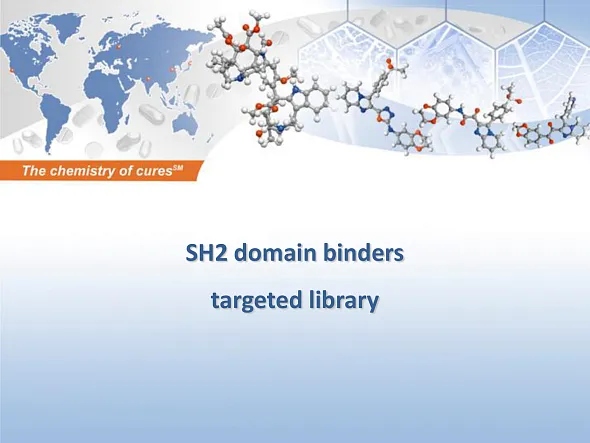SH2 PTB Focused Library
ChemDiv’s SH2 PTB Library comprises a comprehensive collection of 7,000 compounds.
Protein tyrosine kinases (PTKs) play a pivotal role in intracellular signaling pathways, which are integral to the regulation of major cellular processes. Dysfunctions in these PTKs, or the signaling pathways they control, are implicated in a range of diseases, including cancer, diabetes, and immune deficiencies. Key to these pathways are the SH2 (Src homology region 2) and PTB (phosphotyrosine-binding) domains. These small protein modules are crucial for mediating protein-protein interactions within various signal transduction pathways.
Initially, both SH2 and PTB domains were recognized for their role in identifying phosphorylated tyrosines in receptor tyrosine kinases and other signaling proteins. However, subsequent studies has revealed that SH2 domain binding to target proteins is stringently dependent on tyrosine phosphorylation, whereas most PTB domains bind to their targets, which are typically nonphosphorylated, in a constitutive manner. The functional properties of SH2 and PTB domains extend to directing host proteins to specific cellular compartments, regulating the assembly of essential signaling pathway components in response to external stimuli, and controlling autoinhibition, activation, and dimerization of the host proteins [1].
Targeting SH2 and PTB domains presents a promising strategy for developing novel therapeutics, as modulating these interactions can disrupt pathologic signaling pathways linked to disease progression. Drugs that inhibit or modulate the functions of proteins containing these domains are currently investigated as specific therapeutics affecting PTKs. The specificity and effectiveness of such interventions in selectively targeting SH2 and PTB interactions make them attractive candidates for therapeutic development in precision medicine.
References:
[1] J. Schlessinger and M. A. Lemmon, “SH2 and PTB domains in tyrosine kinase signaling” Sci. STKE, 2003, 191, 1-13, doi: 10.1126/stke.2003.191.re12.